The packaging jar market, valued at USD 41.6 billion in 2025 and projected to reach USD 53.3 billion by 2035 at a CAGR of 2.5%, is being shaped by several influential dynamics. Demand for convenience-oriented packaging continues to increase, as food, beverage, and personal care sectors require solutions that balance portability, safety, and shelf appeal. Jars are being adopted as reliable formats for preserving freshness and preventing contamination, which aligns with growing consumer hygiene awareness. This is particularly important in urban markets where ready-to-use and on-the-go consumption is rising.
Material innovation is another key dynamic, with lightweight plastics, glass alternatives, and recyclable polymers becoming central to manufacturing strategies. These advancements allow producers to cut costs while delivering durable and eco-compatible packaging formats that align with regulatory and consumer expectations. The rise of e-commerce and modern retail formats also exerts pressure on packaging design, as jars must now meet requirements for efficient stacking, transport durability, and standardized presentation.
Production efficiency is being enhanced by greater adoption of automation and intelligent packaging technologies. Smart filling, sealing, and design customization enable scalable production while responding to changing consumer demands for both functional and visually distinctive packaging. As consumer preference shifts toward packaging that communicates premium quality while remaining practical, brands are investing in innovative jar designs with enhanced utility features such as resealability, portability, and aesthetic appeal.
Regional demand variations add another layer of growth dynamics, with established markets focusing on premiumization and brand differentiation, while emerging economies prioritize cost-effective and functional packaging jars for expanding middle-class consumption. Together, these drivers are expected to sustain consistent growth, positioning the packaging jar market as a key segment within the global packaging industry during the 2025 to 2035 forecast period.
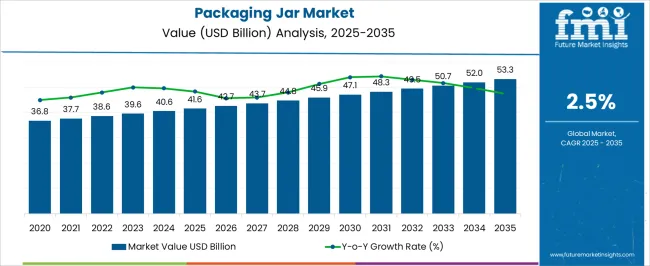
| Metric | Value |
|---|---|
| Packaging Jar Market Estimated Value in (2025 E) | USD 41.6 billion |
| Packaging Jar Market Forecast Value in (2035 F) | USD 53.3 billion |
| Forecast CAGR (2025 to 2035) | 2.5% |
The packaging jar market is segmented by Material, Capacity, and End Use and region. By Material, the packaging jar market is divided into Plastic and Glass. In terms of Capacity, the packaging jar market is classified into 51 To 250 Ml, Up To 50 Ml, 251 To 500 Ml, and Above 500 Ml. Based on End Use, the packaging jar market is segmented into Food Packaging, Cosmetics And Personal Care, Homecare, Chemicals And Pharmaceuticals Packaging, and Others. Regionally, the packaging jar market is classified into North America, Latin America, Western Europe, Eastern Europe, Balkan & Baltic Countries, Russia & Belarus, Central Asia, East Asia, South Asia & Pacific, and the Middle East & Africa.
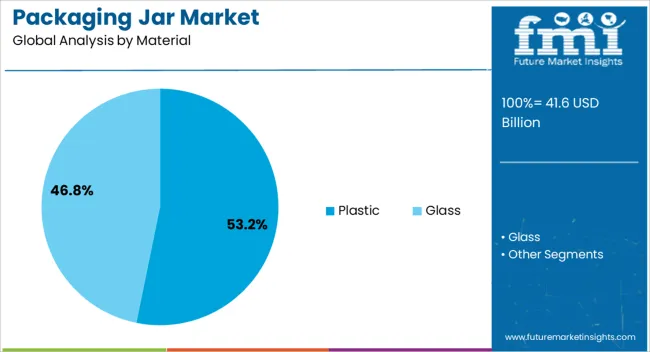
The plastic material segment is projected to hold 53.20% of the Packaging Jar market revenue share in 2025, establishing it as the leading material type. This segment has been driven by the lightweight, durable, and cost-effective nature of plastic jars, which provide superior protection against breakage and contamination.
Plastic jars are highly preferred by manufacturers for their versatility, ease of molding into various shapes and sizes, and ability to maintain product quality over extended storage periods. Additionally, advancements in recyclable and food-grade plastics have enhanced their sustainability and compliance with safety standards, further reinforcing adoption.
The segment’s growth is also supported by the increasing demand for consumer-friendly packaging that is easy to handle, transport, and store The wide availability of plastic materials and established supply chains continue to strengthen the packaging jar market position of this segment.
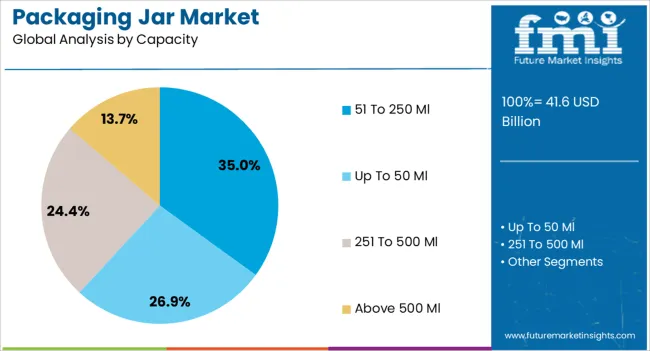
The 51 to 250 ml capacity segment is expected to account for 35.00% of the Packaging Jar market revenue share in 2025, making it a leading capacity range. This segment’s growth has been influenced by the rising demand for portion-controlled packaging suitable for retail, food service, and personal care applications.
Smaller and medium-sized jars offer convenience, precise portioning, and easy storage, which aligns with consumer preferences for ready-to-use products. Manufacturers benefit from the ability to optimize production, reduce material usage, and create standardized packaging that fits various distribution channels.
Additionally, the scalability of this capacity range allows it to serve multiple product types and markets, enhancing its appeal The increasing adoption of these jars in urban and e-commerce settings has further contributed to the prominence of this segment in the overall market.
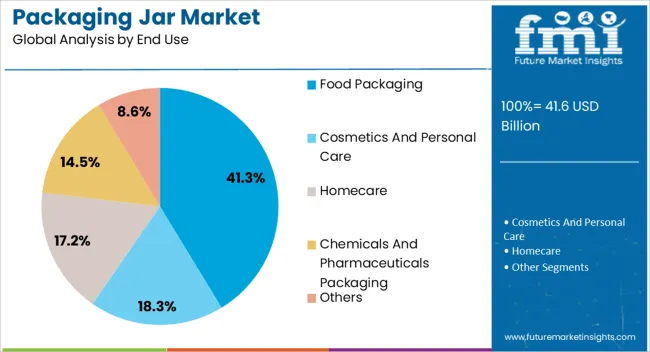
The food packaging segment is anticipated to hold 41.30% of the Packaging Jar market revenue in 2025, making it the leading end-use industry. The growth of this segment is driven by the rising consumption of packaged foods, convenience products, and ready-to-eat meals.
Packaging jars provide safety, preservation of freshness, and ease of transport, which are critical for the food sector. The flexibility of jars in accommodating different product types, combined with advancements in sealing and closure technologies, has increased their adoption.
Additionally, consumer awareness regarding hygiene, contamination prevention, and product quality has further propelled the demand for jars in food packaging Retailers and manufacturers are increasingly prioritizing functional and visually appealing packaging to attract consumers, making food packaging the dominant driver of market revenue growth.
The current generation belonging to Gen-Z and Millennials have been raised in an era of increased environmental awareness. They have witnessed the detrimental consequences of climate change, plastic pollution, and the depletion of natural resources.
This has led to increased demand for sustainable packaging jars. These jars are more inclined toward adopting sustainable alternatives and are conscious of their environmental footprint.
The glass jars' recyclability and eco-friendliness align with their values of reducing waste and conserving the planet. Furthermore, consumers are more health-conscious than their predecessors, causing elevated demand for Mason jar packaging.
Glass jars are considered a safer option for packaging food and beverages. This is due to their lack of inclusion of hazardous chemicals such as BPA, which are found in some plastic materials. The perception of glass jars as a healthier choice has propelled the jar packaging market. This is particularly true for products that are directly consumed from the packaging.
Swelling Demand for Safe Packaging in Cosmetics Industry Pushes Sales
Cosmetics and personal care products are steadily gaining popularity among customers who are becoming more mindful of their appearance. This is driving up demand for packaging jars. Cosmetic jars are favored due to their low weight, ease of use, and strong chemical resistance. In addition, the requirement to store creams, lotions, and skin tonics is propelling demand for packing jars.
In recent years, the packaging jar market has experienced a notable surge in demand within the personal care and cosmetics sectors. The industry upswing can be attributed to a confluence of aspects, including the ingrained properties of glass, changing consumer preferences, and regulatory considerations.
The adoption of packaging jars within the cosmetic industry has met stringent requirements for product preservation and safety. This has also opened avenues for brand differentiation and sustainable practices, ultimately compelling industry development in the forthcoming decade.
Expenditure on Raw Material to Plummet Demand
The expense sensitiveness of raw materials, including sand, soda ash, and limestone, heavily influences glass packaging's market demand. Extending expenditures decipher into more elevated manufacturing costs, which producers may choose to absorb but eventually pass along to customers.
Packaging containers cost more, which lowers pricing relative to alternatives. The demand for glass jars may plunge as cost-conscious customers switch to less expensive packaging. Consequently, variations in expenditure affect the total manufacturing cost of these jars.
Between 2020 and 2025, the packaging jar market recorded a CAGR of 1.6%. The packaging jars had sluggish demand growth, advancing from USD 36.8 billion in 2020 to USD 41.6 billion in 2025.
The demand for packaging jars is having trouble because of rising manufacturing costs, shifting raw material prices, and growing demands on producers to provide eco-friendly designs.
This pressure may affect profitability and result in extra expenses. Furthermore, rigorous regulatory laws are projected to raise new concerns about the usage of packing jars, particularly plastic ones.
Manufacturers may need to reevaluate their plans and create new products that comply with laws that countries are enacting to promote sustainable practices and decrease plastic waste. For the packaging jar industry to resume cultivating and being prosperous in the decade to come, such issues must be resolved.
The industry is foreseen to boost 1.5 times than historical rate of market value due to the increasing preference for durable and rigid packaging solutions. Packaging jars offer convenience and wear and tear properties and are popular for improving product quality, UV protection, and reuse.
Manufacturers are developing bespoke designs and materials, catering to consumer demand and boosting sales of the products in several industries. The outlook of the packaging jar industry is desired to be significant in the upcoming decade.
The section below covers the forecast for the packaging jar market in terms of nations. The United States is anticipated to remain at the forefront in North America, with a CAGR of 1.3% through 2035.
In South Asia and the Pacific, India is projected to witness a CAGR of 4.6% through 2035. At the same time, the demand for packaging jars in the European region, the United Kingdom crowns itself with a CAGR of 1.5%.
| Countries | CAGR 2025 to 2035 |
|---|---|
| United States | 1.3% |
| Canada | 1% |
| Germany | 1.4% |
| United Kingdom | 1.5% |
| China | 4.2% |
| India | 4.6% |
The packaging jar market in India is projected to create an incremental opportunity with a CAGR of 4.6% over the forecast period. As the country’s population rises, the demand for different food and beverages is anticipated to grow.
Indian companies are increasingly utilizing bottles and jars as the preferred packaging for various food items like jams, sauces, spreads, pickles, and drinks. For instance, in May 2025, Rage Coffee, a Delhi-based FMCG company, introduced elegantly styled glass jars with vibrant brand colors crafted in a 'V-shaped frame.
In recent years, the Indian government has presented several regulations to reduce single-use plastic usage and promote sustainable packaging. This has fostered industry innovation by encouraging manufacturers to develop new materials and designs for packaging.
The United States is foreseen to experience a 1.3% CAGR in demand for jars for eCommerce packaging. This is prompted by the demand from the food and beverage industry and the personal care and beauty industry, as the country is one of the largest packaging jar market.
The trend in the United States demand for jar packaging is propelled by the demand for sustainable packaging solutions. This is helmed by environmentally conscious consumers seeking environmentally friendly alternatives.
Manufacturers are researching new materials and designs to meet the growing demand for sustainable packaging options such as paper and glass.
The United Kingdom packaging jar market is projected to highlight a CAGR of 1.5% during the forecast period. The demand for sustainable materials for the packaging bottles and jars concerns over issues of garbage disposal.
Manufacturers in the United Kingdom are investing in the research and development of eco-friendly materials to generate less carbon footprint. For instance, Lidl UK will introduce Prevented Ocean Plastic packaging in June 2025. This is a fully certified recycled plastic made from discarded water bottles found in Southeast Asia within 30 miles of ocean waterways.
Absolut Vodka is also trialing a paper-based bottle in the United Kingdom. This marks the first time a global spirits company will sell a paper-based product in-store. This move aligns with Absolut's goal of becoming carbon-neutral by 2035.
The subsequent section categorizes the packaging jar industry based on different prospects of the product. Based on the material, the plastic material is anticipated to acquire a revenue share of 53.2% in 2025. At the same time, food packaging accounts for 41.3% of the industry share.
| Segment | Plastic (Material) |
|---|---|
| Value Share (2025) | 53.2% |
Consumers are increasingly seeking convenient and easy-to-use plastic jars, accounting for 53.2% of revenue share in 2025. Manufacturers are developing new, BPA-free, and rigid plastic containers to meet this demand, as plastic jars account for a significant portion of revenue.
Governments across the globe are implementing stricter rules to limit harmful plastic manufacturing practices. This is despite the high demand for plastic jars, with a focus on reducing waste and promoting sustainable practices for environmental protection.
Plastic jars' recyclability is a key advantage, leading manufacturers to create innovative products. This not only benefits the environment but also enables manufacturers to meet consumer needs by developing new products that cater to changing consumer needs.
The demand for plastic jar packaging is influenced by convenience features like easy-to-open lids, single-serve options, and on-the-go options, such as resealable lids, straws, or handles.
| Segment | Food (End Use) |
|---|---|
| Value Share (2025) | 41.3% |
In 2025, the food packaging industry accounts for 41.3% of packaging jars, compelled by rising demand for ready-to-eat products. The demand for edible jars is popular due to their versatility, aesthetic appeal, and transparency. This allows customers to inspect products before purchase and contributes to the industry growth.
Packing jars offer versatility in shaping and size, suitable for various food products like sauces, fruits, pickles, and jams. The growing popularity of organic and homemade food items has boosted sales of jars as healthier, sustainable, and eco-friendly packaging options.
Packaging jars provide versatile branding and decoration options, attracting customers with unique designs. As environmental awareness grows, sustainable packaging becomes increasingly important; making jars a dominant choice in the food packaging industry.
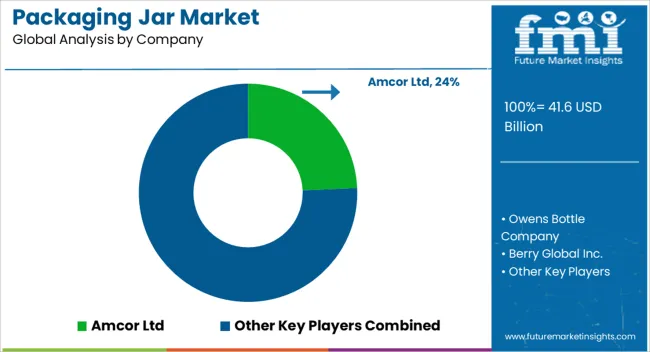
Significant corporations in the packaging jar market are creating and introducing new goods to the industry. The goal is to increase regional presence and integrate with other companies. The trend of devising new products in conjunction and collaboration with start-ups and regional businesses is developing in the forthcoming decade.
The up-and-coming businesses are investing in the creation of unique materials and personalized packaging containers. Prominent companies are using trade tactics such as product launches, mergers and acquisitions, and the construction of production facilities. This is done to advance the functioning of consumer product packaging.
The demand for custom-made packaging jars is on the rise across several sectors, including FMCG, cosmetics, and pharmaceuticals. Brands are investing in the development of diverse designs of jars and containers to promote their products.
Industry Updates
In terms of material, the industry is bifurcated into plastic and glass.
Jars with capacities of up to 50 ml, 51 to 250 ml, 251 to 500 ml, and above 500 ml are described.
Leading end-use industry include cosmetics and personal care, homecare, food packaging, chemicals and pharmaceuticals packaging along with others.
Key countries of North America, Latin America, East Asia, South Asia and Pacific, Western Europe, Eastern Europe, and the Middle East and Africa are covered.
The global packaging jar market is estimated to be valued at USD 41.6 billion in 2025.
The market size for the packaging jar market is projected to reach USD 53.3 billion by 2035.
The packaging jar market is expected to grow at a 2.5% CAGR between 2025 and 2035.
The key product types in packaging jar market are plastic and glass.
In terms of capacity, 51 to 250 ml segment to command 35.0% share in the packaging jar market in 2025.






Full Research Suite comprises of:
Market outlook & trends analysis
Interviews & case studies
Strategic recommendations
Vendor profiles & capabilities analysis
5-year forecasts
8 regions and 60+ country-level data splits
Market segment data splits
12 months of continuous data updates
DELIVERED AS:
PDF EXCEL ONLINE
Plastic Jar Packaging Market Forecast and Outlook 2025 to 2035
Competitive Overview of Plastic Jar Packaging Companies
Packaging Testing Services Market Size and Share Forecast Outlook 2025 to 2035
Packaging Tubes Market Size and Share Forecast Outlook 2025 to 2035
Packaging Barrier Film Market Size and Share Forecast Outlook 2025 to 2035
Packaging Films Market Size and Share Forecast Outlook 2025 to 2035
Packaging Laminate Market Size and Share Forecast Outlook 2025 to 2035
Packaging Burst Strength Test Market Size and Share Forecast Outlook 2025 to 2035
Packaging Tapes Market Analysis - Size, Share, & Forecast Outlook 2025 to 2035
Packaging Materials Market Size and Share Forecast Outlook 2025 to 2035
Packaging Labels Market Size and Share Forecast Outlook 2025 to 2035
Packaging Equipment Market Size and Share Forecast Outlook 2025 to 2035
Packaging Resins Market Size and Share Forecast Outlook 2025 to 2035
Packaging Inspection Systems Market Size and Share Forecast Outlook 2025 to 2035
Packaging Design And Simulation Technology Market Size and Share Forecast Outlook 2025 to 2035
Packaging Suction Cups Market Size and Share Forecast Outlook 2025 to 2035
Packaging Straps and Buckles Market Size and Share Forecast Outlook 2025 to 2035
Packaging Coating Market Analysis - Size, Share, & Forecast Outlook 2025 to 2035
Packaging Testing Equipment Market Analysis & Growth 2025 to 2035
Packaging Bins Market Trends - Growth & Demand 2025 to 2035

Thank you!
You will receive an email from our Business Development Manager. Please be sure to check your SPAM/JUNK folder too.
Chat With
MaRIA